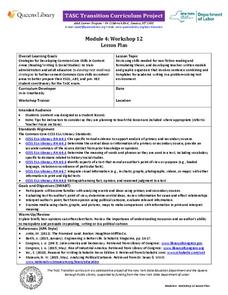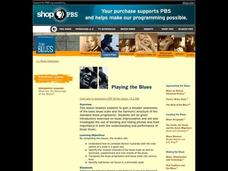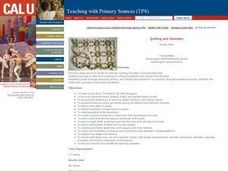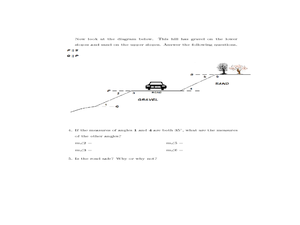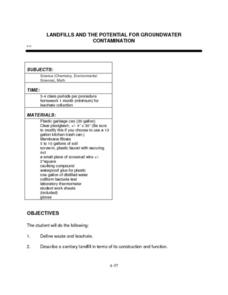K20 Learn
Bavaria Has Issues...Experimental Components
Do you want to be a detective by analyzing situations? An engaging lesson provides young historians with the tools to help them understand the difference between data types and how to analyze them to draw conclusions. Scholars complete...
EngageNY
TASC Transition Curriculum: Workshop 12
How can opinions slant facts? Workshop participants learn how to examine primary and secondary sources and identify the author's point of view. They also examine how visual art impacts the meaning and rhetoric of sources. Full of...
New York State Education Department
TASC Transition Curriculum: Workshop 11
You'll C-E-R a difference in classroom achievement after using a helpful lesson plan. Designed for economics, civics, government, and US history classes, participants practice using the CER model to craft arguments about primary and...
Curated OER
Diversity of Colors
Young scholars investigate color diversity by experimenting with jelly beans. In this color spectrum lesson, students observe colored jelly beans through different filters and light sources to change the existing look of the bean....
Curated OER
Biomimicry, Nature: Architecture of the Future
Students explore the relationship between nature and architecture. In this cross curriculum history, culture, and architecture lesson, students observe and discuss structures visible in nature. Students view websites in which Native...
Odyssey of the Mind
Odyssey of the Mind Curriculum Activity: Mathematicus Dramaticus
The best part about this resource is that you've got four wonderful activities to choose from. Each of the projects can work together or on its own to help learners understand the history of math and how it can be seen every day. In...
Curated OER
Fly, Fly Away
Students use materials from their own environment to design a kite. For this kite design lesson, students research the history of kites and obtain a formal mathematical definition of a kite. Students sketch kite designs after discovering...
Curated OER
"Adding It Up" at James Fort
Students discuss jettons and their archaeological importance at Jamestown. They then practice using historic counting sheets and artifacts to understand the calculating methods of the early 17th Century, and identify their similarities...
Curated OER
Mapping and Excavating a Jello Mold
Fifth graders, in groups, map the three layers of different colored jello layers in molds and note the placement of fruit in them. On the grid paper they draw each grape, raisin, or other object and carefully remove each layer. After...
Curated OER
History, African Americans, The Blues
This lesson enables teachers to use blues music to explore the history of African Americans in the 20th century. By studying the content of blues songs, students can learn about the experiences and struggles of the working-class...
Curated OER
The Blues . Music Education
What ultimately influences a musician's creations? Is it the time in which he/she lives, his/her personal experiences, the music of the time and previous times, or the image the artist hopes to convey? This lesson explores these...
Curated OER
Music Education, Playing the Blues
This instructional activity enables young scholars to gain a broader awareness of the basic blues scale and the harmonic structure of the standard blues progression. Students will be given introductory exercises on blues improvisation...
Curated OER
Geometry and Quilting
Students create a quilt square for a class quilt using at least three, two-dimensional geometric figures. They research and write a brief description of at least two different quilt patterns that they find. Pupils discuss that quilts are...
Curated OER
Botanical Discoveries
Sixth graders examine the Lewis and Clark Expedition. In this plant discovery activity, 6th graders put in chronological order the plant discoveries of Lewis and Clark. Students understand the characteristics of leaves and find the area...
Curated OER
Proteomics
Students analyze data taken from proteomic experiments. In this biology lesson, students explain the importance of bioinformatics tools in the study of proteins. They evaluate scientific results using math and computer software.
Curated OER
The Tipping Point
Students rewrite word problems and solve using math. In this word problem lesson plan, students gather data and observe the data. They relate this process to the scientific method and math. They review their data to be able to answer...
Curated OER
"how To Think Like an Archaeologist" Suggested Pre-visit Activity for Historic Jamestowne
Young scholars study grocery receipts to simulate the archaeological activity of classifying items. They discuss the receipts as if they were find lists.
Curated OER
Gathering, Recording, and Presenting Data
Sixth graders use the local newspaper to find and discuss examples of uses of statistics and the ways in which the information is presented. They create and represent their own set of data showing how students get to school each day.
Curated OER
Landfills and the Potential for Groundwater Contamination
Students examine how a sanitary landfill is constructed, how it functions, and how waste and leachate affects the areas around the landfill. After a discussion about landfills and leachates, students construct a Sanitary Landfill Model...
Cornell University
Cornell University: Law School: Property Tax Overview
This resource gives an overview of adoption law with links to key primary and secondary sources.

